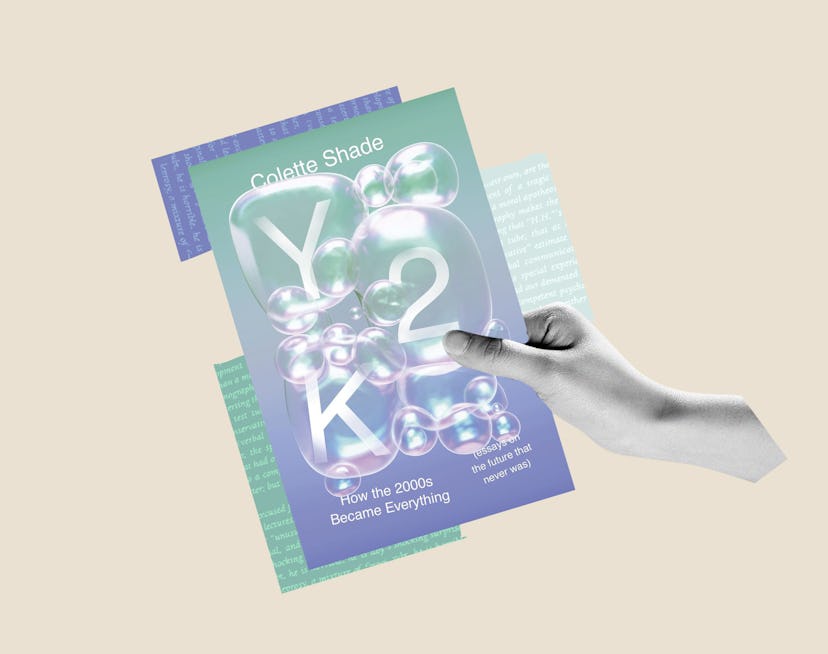Bustle Book Club
Y2K Trends Are Back, But What Happened To The Optimism?
Colette Shade’s new book explores the era’s cultural output — and the sociopolitical trends that informed it.

In 2018, Colette Shade found a letter she’d written for a time capsule in elementary school. At age 11, she’d been asked to imagine what the year 2008 would be like, and had painted a sunny picture. “I predicted I’d be a junior at Stanford University, that we’d be watching movies over the computer over the internet, and that we’d be starting to do something about climate change,” Shade, now 36, says, laughing. “Things went so differently than I had predicted, mostly for the worse, both in my own life and in the world more generally. I just got really curious — what was it that allowed me to feel so optimistic in 1999?”
To answer that question, she began writing her debut book, Y2K: How the 2000s Became Everything (Essays on the Future That Never Was). She reveals her findings over 10 chapters, in which she plumbs both her personal history and broader cultural trends from the decade. “I was the product of a historical moment that basically saw itself as operating outside of history,” says the Baltimore-based writer, nodding to the economists, historians, and political scientists who cheerily declared history over in the ’90s. “And if you look at pop culture, that’s also reflecting this really optimistic view of the future. I’m thinking of the ‘No Scrubs’ video, where TLC is on a spaceship and they’re wearing these cool silver outfits.”
With the Cold War in the rearview and the internet opening up a new digital world, surely, things were on the up and up?
The fantasy wouldn’t last long, thanks to the persistence of war, the instability of the global financial system, and continued bigotry of all stripes. And yet, nostalgia for that optimistic time has never been higher — Shade has been known to listen to Smash Mouth’s Astro Lounge on repeat, while scrolling through scans of old dELiA*s catalogs. The yearning seems particularly strong among Gen Z and Gen Alpha, who are too young to remember the days of blow-up furniture and butterfly clips, but still find themselves drawn to the era’s aesthetics. “I hope my book resonates with them, and also gives them a little bit more context for the trends,” she says.
Below, Shade discusses her writing routine, what she snacks on as she types, and why she’s a big believer in putting in the hours.
On Her Favorite Recent Reads:
I really enjoyed Lydia Kiesling’s novel Mobility. It’s sort of a comedy of manners, which I love, but it also situates the character within this bigger historical story that [the character is] not really aware of. I also really enjoyed John Ganz’s When the Clock Broke. It’s a really good history of the culture in politics of the early ’90s, so it’s, like, almost a prequel to my book, except [When the Clock Broke] doesn’t have the personal essay part of it.
On Her Writing Setup:
I write at home, either at at my desk or at the kitchen table on my laptop. I like to get up and pace around a lot, so I don’t really like to work in coffee shops because that’s generally frowned upon.
On Her Go-To Snacks:
I love French press black coffee, and every day I eat oatmeal for breakfast with lots of walnuts or nut butters, and fruits. Because I prefer to write in the morning, that’s usually what I’ll be eating while I’m writing. In terms of fun snacks I keep around, lately one of my favorites has been Tsiona chips. I don’t think they’re distributed nationally yet, but it’s this company run by a woman in Rockville, Maryland. She’s Ethiopian, and they’re injera chips that come with these lentil dips that basically taste like Ethiopian lentil stews.
On Her Nostalgic Playlist:
I have this playlist that I made for the book to channel the feelings of whatever age [I was at the time], whether that’s age 9, 10, 15, or 20, as well as the era that I’m writing about.
On Putting In The Time:
There’s this idea that you should only write when you feel inspired, but I haven’t found that to be effective, and I don’t think I know any writers who are successful who do that. You have to treat it almost like going to the gym, where you sort of set a timer for 30 minutes and just write.
I used to play trumpet, and basically every day you have to practice or you won’t be good — you lose what’s called your embouchure, which are the muscles in your lips. Now, that doesn’t mean every day you’re going to get up on stage and play something for a crowd that’s perfect and beautiful. Most days, you’re doing your scales for a few minutes and doing a couple runs through a piece. It’s about staying in shape.
This interview has been edited and condensed for clarity.